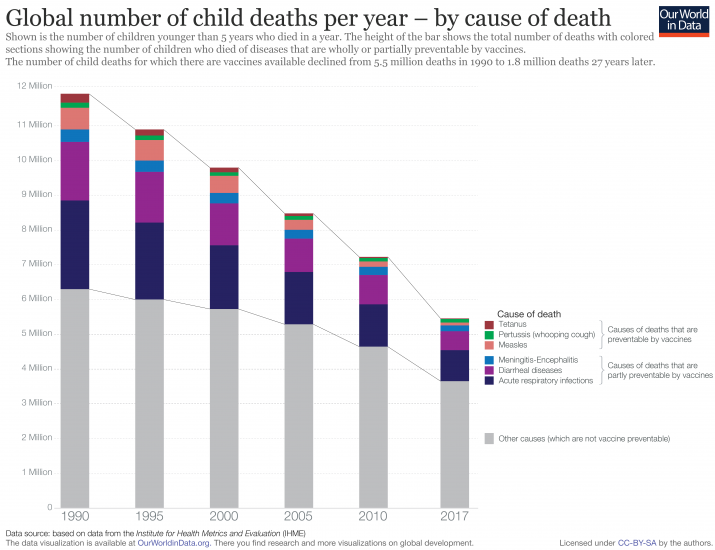This week – 24-30 April – is World Immunization Week. The theme of this year’s World Immunization Week is collective action to protect every person in the world from “vaccine-preventable diseases” (VPDs). VPDs are 25 viral and bacterial diseases listed by the World Health Organization (WHO) that can be prevented by vaccination.
Not only can individual deaths be avoided, but transmission of infectious diseases can also be interrupted if vaccination rates are high enough. This means that even those who are not vaccinated also gain protection.1
The ultimate goal in public health is often seen to be the eradication of disease through vaccination, as has been achieved for smallpox and it is in close sight for polio. The world was able to reduce the number of paralytic polio cases from over 350,000 per year in the 1980s to just 42 cases in a year, as we show in our entry on polio.
The WHO estimates that 2 to 3 million deaths are prevented every year through immunization against diphtheria, tetanus, whooping cough, and measles.2
Nonetheless, the WHO also estimates that VPDs are still responsible for 1.5 million deaths each year.
In the chart we see the global number of deaths of children younger than 5 years per year from 1990 to 2017. The number of deaths which are wholly or partially preventable by vaccines are shown in color.3 The chart shows that the reductions in child deaths over this 25-year period were primarily achieved by a reduction of the number of deaths from vaccine-preventable diseases: The decline in causes which are not vaccine preventable has been modest, while the number of child deaths caused by diseases for which vaccines are available declined from 5.1 million deaths in 1990 to 1.8 million deaths 27 years later.
Two vaccines are responsible for saving millions each year: ‘DTP’ against diphtheria, tetanus, and pertussis (whooping cough) and ‘MMR’ against measles, mumps, and rubella.4 Before the measles vaccine was introduced in 1963, measles caused a large number of deaths globally, estimated at 2.6 million each year. Because about 86% of the world population is immunized today, the number of people killed by measles have been cut dramatically to an estimated 95,000 deaths in 2017. Tetanus and pertussis were also previously much bigger killers, with pertussis affecting especially children younger than 5 years and tetanus striking newborns (killing an estimated 787,000 newborns in 1988, compared with 49,000 in 2013).

However, the gains in global vaccination coverage have slowed down slightly in the last few years. The WHO estimates that 19.5 million infants worldwide are still at risk of VPDs because they miss out on basic vaccines.5
In addition, all the recommended doses of a vaccine need to be received for it to be most effective. In the case of measles three vaccine doses are recommended. Even though an estimated 85% of children receive their first dose of the vaccine, this drops to 64% for the second dose. Therefore, it is not only lack of vaccination that is a problem, but it is under-vaccination that leads to deaths from VPDs.
What then are the most deadly VPDs? Which diseases continue to kill the most people?
Tuberculosis: Determining which are the most deadly VPDs requires acknowledging that some vaccinations are more effective than others. While most vaccines included in national routine schedules are highly effective, a better vaccine for tuberculosis (TB) is desperately needed. It is Sub-Saharan Africa and parts of Asia in particular that are affected by TB, as the world map here shows.
The vaccine for TB – Bacillus Calmette–Guérin (BCG) – has been in use for nearly 100 years. It protects against severe forms of TB but is not effective against pulmonary TB (in the lungs) and has variable effectiveness against TB in adults.6 7 Furthermore, resistance of antibiotics used to treat TB is increasing, meaning some people can no longer be cured by drugs. The estimated number of people in 2016 with multi-drug resistant TB was 490,000.
The fact that there is not a fully effective vaccine and that antibiotic treatment is facing serious difficulties makes TB the most deadly VPD, as we see in the chart. This chart shows the latest data on the number of deaths from VPDs. In 2017 more than 1 million people died as a result of TB.
Meningococcal meningitis and hepatitis B are also deadly VPDs.8
There are even more deadly diseases for which there are vaccines that can prevent some (but not all) deaths – we focus on these in the ‘additional discussion’ below.
In World Immunization Week it is a good moment to look at what we have achieved and what we have to work on next. That 2 to 3 million deaths each year are prevented through immunization shows the capability and imperative of vaccination. The prospect that vaccines could prevent an additional 1.5 million deaths each year makes clear what is within reach if the efforts to fight VBDs are continued.

